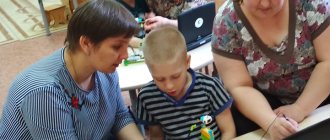Innovations in a modern preschool educational institution
Management structure: development program.
Organizational structure: diagnostics – forecasting – organization – practice – generalization – implementation.
Life cycle of innovations.
1. Discovery stage: inception, emergence of the concept of innovation.
2. Development: invention, creation of an innovation embodied in an object (material or spiritual).
3. Implementation of innovation: practical application, refinement, lasting result, independent existence of innovation subject to receptivity.
4. Dissemination, replication: widespread introduction, diffusion or dominance of an innovation in a specific area, the innovation ceases to be such, loses its novelty.
5. An effective alternative, or its replacement, or a reduction in the scope of application of the innovation.
The linearity of the stages may be violated: within one stage others are permissible, breaks, phase loss, etc. are possible. From the fourth stage there is continuous improvement.
From the point of view of interaction with the environment, the life cycle includes:
· start;
· fast growth;
· maturity;
· saturation;
· a crisis.
Stages of perception of innovation according to Eric Rogers.
1. Familiarization: a person hears about an innovation for the first time and is not yet ready to receive additional information.
2. Appearance of interest: interest + search for additional information. While the internal need to accept innovation is impossible (the subject does not try it on himself).
3. Evaluation: the subject tries on the innovation and decides whether to use it, looks for clarifying information, and critically evaluates it.
4. Approbation: portioned application in practice, depending on the result - acceptance or refusal.
5. Final perception: the decision follows to adopt the innovation and widely use it in practice (through evaluation of the results of the fourth stage).
The presented parameters of the innovation process need to be adapted to the preschool education, which is currently characterized by the dynamics of individual areas and processes. It is innovations that are designed to synchronize and integrate the main aspects of the functioning and development of preschool educational institutions in order to ensure the quality of preschool education.
Conclusion
The ongoing changes in the preschool education system are due to the objective need for changes that are adequate to the social development and evolution of the educational system, which is reflected in the awareness of the pedagogical community of the need for serious changes in the functioning of the institution.
The search and development of innovations that contribute to qualitative changes in the activities of preschool educational institutions is the main mechanism for optimizing the development of the preschool education system. Many researchers associate the development of preschool educational institutions with the processes of targeted development and creation, implementation and mastery, dissemination and stabilization of innovations, which determine its qualitatively new state. It should be noted that the degree of innovativeness of education is determined by the level of development of society and dictated by the level of “underdevelopment” of education. In other words, innovation occurs where and when there is a need for change and the ability to implement it.
Algorithm for introducing innovations in a preschool institution article
Algorithm for introducing innovation
The process of introducing innovation consists of several stages: diagnostic; prognostic; organizational; practical (implementation); generalizing; implementation
The diagnostic stage consists of a systematic analysis of the activities of a preschool educational institution based on monitoring and identifying the main contradictions in the educational process. The result of analytical activity is the identification of problems, the formation of a research topic and its justification. This stage also includes an analysis of the conditions available for conducting the research: personnel, material and technical, cultural-historical, socio-economic, etc. At this stage, the basis of the experiment and the participants in the educational and management process are determined.
The forecasting stage involves the development of a concept of innovation activity and its plan-program.
The concept is developed by a group of trained teachers under the leadership of the head or deputy head of educational work in consultation with the staff of the educational institution. An important procedure is to determine the goal, object, subject, hypothesis and objectives of innovation activity.
A goal can be considered as an expected result of an activity, expressed in positive changes in the educational process.
The goals and objectives of innovative activity are determined on the basis of a thorough analysis of the current situation in a preschool organization, on the one hand, and from development forecasts, on the other.
The selected goals and objectives in a comprehensive target program must be agreed upon at all levels, approved by the majority of the team, realistic, adapted to new conditions, increase the level of motivation and stimulation, and ensure control.
When thinking about the purpose of experimental work, it is recommended to answer the following questions: what do you want to implement, change or test? What do you want to get (create) as a result of innovation? When developing research objectives, it is advisable to determine: what actions need to be taken in order to achieve the goal, what intermediate results are necessary for this, and what steps should be taken.
Then the object and subject of research are determined.
The object of study is the pedagogical space, the area within which contains what will be studied.
The subject of research is the properties, relationships, functions identified in the object. This is the specific part of the object in which changes will directly occur, and on which pedagogical or managerial influence will be directed in the process.
A research hypothesis is a scientifically based assumption regarding the method of implementing the idea and design of the experiment, a system of measures for its implementation. In order for the hypothesis to be clearly defined, it is necessary to think about what exactly will be tested during the experiment, how its idea and design can be more successfully implemented, and what control actions need to be applied to implement the objectives of the experiment.
Next, it is necessary to determine the stages of innovation activity, their specific content, timing of implementation and expected results for each stage. An important point in developing the concept is the determination of indicators for assessing the effectiveness of innovations and monitoring their results.
Organizational stage. The need for this stage is associated with the educational institution obtaining the status of an innovation platform. To do this, the administration of the preschool educational institution carefully studies the following issues:
the state of the institution’s resources: financial, material and technical, information, personnel, regulatory, etc., necessary for organizing innovative activities;
the ability to attract additional resources to ensure innovative activities;
readiness of participants in the educational process for upcoming activities (their competence, motivation, creativity, etc.).
The next stage of work at the organizational stage is to go through the procedure for assigning the status of an innovation platform to an institution in the expert council. The expert council is formed by the education management body (federal, regional, municipal). For the expert council, the administration of the preschool educational institution is preparing a package of documents:
an application to assign the institution the status of an innovation site;
concept of innovation activity;
plan for innovation activity (for its entire period);
additional cost estimate for its organization and implementation.
Competent teachers with a high level of qualifications take part in the implementation of the innovation activity program.
A creative group is created in an educational institution, which includes: a scientific supervisor (if the innovation is scientific and experimental in nature), the head of a preschool educational institution, a deputy head for educational work or a senior educator, teachers participating in innovative activities, representatives of educational authorities . The head of the institution issues an order approving the composition of the creative group, regulations are developed on the activities of the creative group to implement the innovation in the preschool educational institution, and a schedule for introducing the innovation is developed.
The task of the creative group is to exercise internal control over the progress and results of innovation activities. The creative group hears reports from participants in innovation activities at its meetings, makes adjustments to its organization, develops criteria and procedures for assessing the effectiveness of innovation activities.
The organizational stage involves the development of a new edition of the Charter of the preschool educational institution, the distribution of management functions, and the development of job descriptions for all participants in innovation activities.
An important point at this stage is the development of a plan for advanced training of teachers, specialists, parents and other participants in the experiment. Innovative activities require an in-depth study of scientific and methodological literature, the development and mastery of new ways of working with children, mastering research methods, etc. The organization of this activity is carried out by the scientific supervisor (consultant, if he is involved in the innovation process) and the deputy head of the educational part of the preschool institutions.
This stage also includes the preparation of scientific and methodological support: preparation of a specific program, presentation of the technology of innovation, preparation of methodological developments and teaching aids, materials related to the management of innovation.
Practical (implementation) stage. Work at this stage begins with determining the initial level of the state of the problem chosen for innovation activity. For this purpose, system diagnostics of the state of the pedagogical process in experimental and control groups is used[1]. To study the initial state of the pedagogical process in preschool educational institutions, the most adequate research methods are selected to help diagnose, analyze and summarize the results and bring them to the attention of all participants in the pedagogical process. Based on the results obtained, the hypothesis can be adjusted and changes made to the innovation program.
The practical stage of the research is the consistent implementation of an innovative project, the collection and analysis of various research materials indicating the dynamics of the educational process, their systematic discussion at meetings of the scientific and methodological council, solving problems that arise during the work, and timely making adjustments to the course of the research.
To obtain more objective and reliable results about the impact of a particular technology on the development of a child (teachers and specialists, the educational process, management models, etc.), the results are compared with control groups of children, teams of teachers, and other management models. It is important that the objects taken for control work in similar socio-economic, personnel and other conditions. The difference between one object and another lies in the fact that in the control object the work is carried out according to different rules, usual for mass practice.
The practical (implementation) stage usually lasts for a long time. The total duration of innovation activity depends on the specifics of the problem being developed.
The generalizing stage of innovation activity is the processing of the received materials, namely: their qualitative and quantitative analysis based on the developed evaluation criteria; correlation of results with set goals, objectives and scientific assumptions; description of the progress and results of innovation activities; formulating conclusions about the confirmation or fallacy of the hypothesis. Positive results of innovation activities confirm the hypothesis. The consequence of this are facts, established patterns, obtained by researchers in the course of their work. Credibility and objectivity
The results are confirmed by the final diagnosis.
Implementation stage. At this stage, innovative technologies are being disseminated within the team of a given institution or outside it (district methodological Center, etc.). The results of innovative activities can be presented in the form of reports at pedagogical councils, scientific and practical conferences, and also published in specialized literature.
Thus, the introduction of innovation requires the transfer of management activities and methodological work into its new state - the innovation space. In understanding the essence of innovative processes in education, there are two most important problems of pedagogy - the problem of studying, generalizing and disseminating advanced pedagogical experience and the problem of introducing the achievements of psychological and pedagogical science into practice.
[1] To study the level of mastery of educational programs and the characteristics of children’s development, you can use a number of manuals: “Preparing for certification” (St. Petersburg, 2004); “Self-assessment of a manager’s performance as a factor in improving the quality of management of a preschool educational institution” by L.M. Manevtsova and S.S. Lebedeva (2002), etc., related to a specific research topic
Types of innovative activities of preschool educational institutions
Innovative activities of a preschool educational organization can be implemented in the following types:
- The use of modeling technology in organizing interaction between a teacher and children, between a teacher and parents.
- Teachers attend advanced training courses, listen to online lectures and webinars, attend lectures and seminars aimed at improving the skills of teachers and improving their professional skills.
- Search and development of new ways of working with children, methods and technologies of educational work.
- Analysis of the development of each pupil.
- Health-saving technologies. They are focused on maintaining the health of students at an optimal level. For this purpose, a set of health-improving measures and procedures is being introduced, an optimal atmosphere and comfortable conditions for the child to stay in the preschool educational institution are created.
- Information and communication technologies. They are associated with the use of multimedia in the educational process: televisions, PCs, interactive whiteboards, video equipment, audio equipment. These technologies help motivate preschoolers to learn, as they make the learning process more exciting for the child.
- Creating conditions for the safe stay of a child in a preschool educational institution.
- System of environmental education for preschool children.
- Formation of a subject-developmental environment in a preschool educational institution.
- Organization of new forms of interaction with parents, allowing them to participate in the educational process. This includes organizing various preschool events, conducting joint excursions and other trips, creating family clubs, publishing newspapers informing parents about the activities of the preschool and the life of the group of preschoolers, etc.
Get paid for your student work
Coursework, abstracts or other works
Organization of innovative activities in preschool educational institutions
Definition 1
Innovative activity in the educational sphere is a system of measures aimed at introducing innovations into the educational process, thanks to which its renewal and development are realized.
The introduction of innovations into the work of a preschool educational organization is aimed at improving its functioning and improving the quality of provision of preschool educational services.
Innovative areas of activity in preschool educational institutions make it possible to make the educational process variable, to satisfy the needs of the family and the child’s needs for social formation and personal development.
The inclusion of innovations in the organizational work of preschool educational institutions requires management to motivate the entire team of workers to innovate. Innovations should be introduced taking into account the level of professional development of teachers, their psychological readiness for changes and innovations, the ability and willingness to use new methods and technologies of work, creative orientation of activities, readiness to take on large volumes of teaching work and new types of workload.
Are you an expert in this subject area? We invite you to become the author of the Directory Working Conditions
Figure 1. Innovative work in preschool educational institutions. Author24 - online exchange of student work
The main directions of organizational work of innovative activities of preschool educational institutions include the following:
- Creation of special units in kindergarten, i.e. groups of teachers involved in developing creative activities, identifying and analyzing problems;
- The use of active forms of methodological work with the teaching staff, i.e. use of innovative activities - business games, modeling, design methods;
- Creation of programs for professional growth and development of teachers, their training and retraining, taking into account the characteristics of personal development, the needs and capabilities of each teacher, the level of their professional development and qualification characteristics;
- Searching for information about advanced pedagogical experience in the field of introducing innovative products into the work of preschool educational institutions;
- Creation of a card index and video library of information material, methodological developments affecting the introduction of innovative products, methods and technologies for organizing the educational process of preschool educational institutions.
Finished works on a similar topic
Course work Innovative activities in preschool educational institutions 480 ₽ Abstract Innovative activities in preschool educational institutions 270 ₽ Test work Innovative activities in preschool educational institutions 210 ₽
Receive completed work or specialist advice on your educational project Find out the cost
Innovative activities should be organized in such a way that they contribute to improving the quality of education and the effectiveness of the educational work of teachers.
The organization of innovative activities of preschool educational institutions is focused on solving the following tasks:
- Development of the personality of each student, taking into account the manifestation of his individuality.
- Formation of skills of independence and initiative in preschoolers.
- Activating creative self-expression and unlocking the creative potential of preschool children.
- Development of motivation for research and knowledge.
- Development of motivation for active types of activities of pupils: physical, creative, mental.
- Formation of creative thinking skills.
- Increasing the level of mental development of preschool children.
- Development of a spiritually enriched and morally oriented personality.





